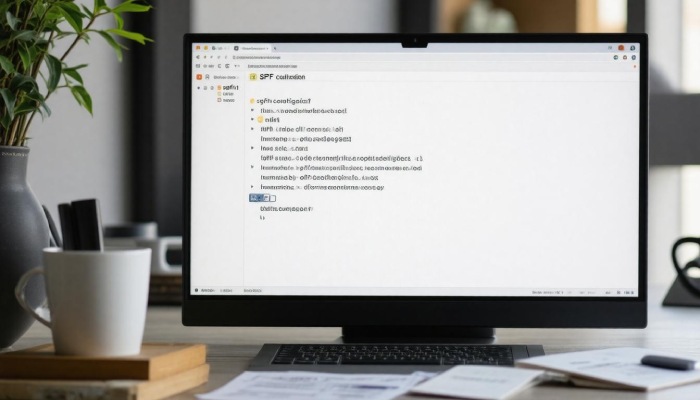What is an SPF Record?
At its essence, an SPF record, or Sender Policy Framework record, acts as a gatekeeper for your email. It is a specific type of TXT record published in your domain’s DNS settings, designed to help prevent unauthorized users from sending emails that appear to come from your domain. By specifying which IP addresses are authorized to send emails on behalf of your domain, it helps ensure that only legitimate messages reach recipients’ inboxes.
When an email arrives at a receiving server, one of the first steps it takes is to check the SPF record associated with the sender’s domain. The server looks at the IP address from which the email was sent and compares it against the list of authorized addresses outlined in the SPF record. If it’s a match, the email is deemed trustworthy; if not, the server may flag it as suspicious or automatically direct it to the spam folder.
Think of it like a bouncer at a club—only those on the guest list get in. By having a well-defined SPF record, you’re essentially crafting a definitive list of who can—and cannot—send emails using your domain name. This proactive measure significantly reduces the risk of spam and phishing attacks which might harm your reputation and compromise sensitive information.
Why SPF Matters
When you consider email security, an SPF record stands out as a necessary defense tool. It’s crucial because it acts as a protective barrier against spammers who might try to exploit your domain for their malicious activities. Without this safeguard in place, you leave yourself vulnerable to issues such as bad deliverability rates and potential damage to your brand reputation.
In fact, many service providers, like Gmail, rely heavily on SPF records when determining if an email should land in the recipient’s inbox or be tossed aside as spam. If you don’t have proper SPF records configured for your domain, you risk having genuine emails disregarded by clients or customers due to some rogue actor spoofing your address.

An illustrative example would involve an SPF record that looks like this: “v=spf1 ip4:192.0.2.0/24 include:_spf.google.com ~all.” Here’s what this means: this configuration allows any email traffic from IP addresses in the range of 192.0.2.0 to send messages on behalf of the domain while also permitting Google servers to do so too. Meanwhile, other unspecified IPs will receive a soft fail indication—a warning sign rather than outright rejection—meaning they might face enhanced scrutiny during the authentication process.
This understanding highlights how critical it is for organizations to implement effective controls over their emailing practices, thereby protecting both their identities and customers from fraud while improving overall email performance and trustworthiness.
Importance of SPF in Email Authentication
SPF records are pivotal in today’s digital landscape, acting as a bulwark against the ever-looming threat of phishing attacks and email spoofing. With nearly 90% of data breaches linked to phishing tactics, as highlighted by a 2023 report from Verizon, having a robust SPF record is not just beneficial; it’s essential.
These records serve as a first line of defense by verifying whether an email is genuinely sent from an authorized server recognized by the domain owner. This verification process can help filter out deceptive emails before they even come close to your inbox, thereby significantly reducing the risk of falling prey to phishing scams.
It’s staggering to note that domains equipped with SPF records can reduce their chances of being used in phishing attacks by up to 70%.
In addition, according to studies, organizations that have implemented SPF report improvements in email deliverability rates by as much as 20%. Just imagine: your legitimate emails reaching recipients instead of landing in spam folders—this is what an SPF effectively contributes to your email communications.
When an email hits a receiving server, it checks the SPF record for validation. If the sending IP matches, the message gets through; if not, depending on how the record is configured—perhaps it’s labeled with ‘-all’ for a hard fail—the message may be discarded outright. In this way, SPF doesn’t merely protect your reputation; it also enhances overall trust regarding your email traffic. As a business owner or someone managing a corporate domain, this means your interactions remain professional and credible.
Take it from John Smith, IT Manager at XYZ Financial: “Implementing SPF records brought down the incidence of phishing emails in our organization by 80% within six months.” Such testimonials are transformational and speak volumes about the tangible benefits these records can offer when they are properly configured.
With this understanding of SPF’s importance firmly established, we can now explore the practical steps required to configure these records for your domain.
How to Set Up Your SPF Record
The first essential step in establishing an SPF record is to identify the sources that are authorized to send emails for your domain. Think of these sources as your trusted friends who have the green light to represent you in important communications. This involves listing all IP addresses, third-party services like Mailchimp or SendGrid, and mail servers that send out emails on your behalf. Having this comprehensive list clarifies which entities need permissions within your SPF record.

Once you know your authorized senders, it’s time to construct the actual SPF record syntax.
Step II – Format the SPF Record
Crafting a valid SPF record is crucial. The basic structure follows the format v=spf1 <mechanisms> <qualifiers> all, where ‘v=spf1’ indicates you’re using Version 1 of the SPF protocol. Mechanisms, such as ip4, ip6, mx, and include, help define what email sources are permitted. You can think of these mechanisms as different doors through which authorized messages can pass, while the qualifiers—such as + (pass), – (fail), or ~ (soft fail)—signal how strict you want to be about allowing or denying emails from those sources.
With your mechanisms and qualifiers set, it’s essential to incorporate this information into your domain’s DNS settings.
Step III – Add the Record to Your DNS
Accessing your domain’s DNS settings is often done through your domain registrar or web hosting provider. After logging in, look for the section designated for managing DNS records. Here, you’ll create a new TXT record that contains the SPF configuration you previously formulated.
The following is an example of how this could look:
v=spf1 ip4:192.0.2.0/24 include:spf.protection.outlook.com -all
- Here, ip4:192.0.2.0/24 specifies an allowed range of IP addresses.
- The include:spf.protection.outlook.com ensures that emails sent via Outlook are recognized as legitimate.
- The -all qualifier denotes that any email not conforming to these rules should be rejected outright.
Taking care with each aspect here is vital, as improper configurations can lead to significant email deliverability issues down the line.
Once your SPF record is live, verifying it is essential to ensure it operates correctly and safeguards your email communications effectively. Next, we will explore the practical steps involved in confirming that your setup functions seamlessly and addressing any potential issues that arise.
Verifying and Troubleshooting SPF Records
Verifying your SPF record is akin to a safety check; it ensures that your email domain is secure from being misused by unauthorized entities. One of the simplest ways to verify your SPF record is to use online tools such as MXToolbox or an SPF Record Checker. These tools will analyze your TXT records in the DNS for any discrepancies and provide immediate insights into potential issues. It’s like having an extra pair of eyes—ones that know exactly what to look for!

However, while these tools can make validation easy, it’s essential to possess some fundamental technical knowledge so you can interpret the results effectively.
Some may argue that relying solely on automated tools can oversimplify matters, leading to complacency regarding deeper issues within your email configuration. Though verification tools can pinpoint immediate concerns, understanding how SPF works enhances your ability to troubleshoot more complex problems down the line. Educating yourself about SPF mechanisms and qualifiers aids in mastering the nuances of email authentication, empowering you to handle any challenges.
Common Errors
One of the frequent pitfalls encountered in SPF records includes exceeding DNS lookup limits—something many users grapple with without realizing it. The limit for DNS lookups is capped at ten; if you have too many “include” statements, you’ll exceed this quota and face validation failures. An overabundance of intricate entries can complicate both functionality and maintenance. To address this concern, combine and simplify your SPF entries whenever possible.
Here’s a helpful table summarizing some common errors you might encounter when working with SPF records:
| Error Type | Cause | Solution |
| Exceeding lookup limit | Too many includes | Combine and simplify SPF entries |
| Syntax errors | Incorrect format | Validate using SPF check tools |
| No SPF record found | Not published in DNS | Publish correct SPF TXT record |
| Unrecognized mechanisms | Typos or invalid mechanisms | Ensure all mechanisms are valid |
Understanding these common issues paves the way for a smoother experience with email authentication. Moreover, it’s essential to explore how this protocol interacts with other methods used for securing email communications.
Comparing SPF with Other Protocols
SPF, or Sender Policy Framework, isn’t just a solitary shield guarding your emails; it’s part of a formidable triad that also includes DKIM (DomainKeys Identified Mail) and DMARC (Domain-based Message Authentication, Reporting & Conformance). Each plays a unique role in fortifying your email authentication.
DKIM and DMARC
Let’s break it down: while SPF determines whether the sender’s IP address is authorized to send emails for your domain, DKIM takes an extra step by adding a cryptographic signature to verify that the message hasn’t been altered during transit. This means that if someone modifies an email en route, the recipient’s server will know something’s amiss.
In contrast, DMARC operates on top of both SPF and DKIM by introducing policies for how to handle any emails that fail these checks.

Here’s what you need to know about each protocol:
- SPF focuses primarily on verifying the sender’s IP, ensuring it’s listed as an authorized sender but doesn’t validate what’s inside the email.
- DKIM acts like a reliable seal of approval, confirming that the content remains intact from when it left the sending server to when it reaches the recipient.
- DMARC adds yet another layer of protection by providing explicit instructions on how to treat emails that don’t pass either SPF or DKIM checks, whether that’s rejecting them outright or placing them into quarantine.
By combining these three protocols, you’re creating a comprehensive system of checks and balances for your email communications. This is key: a well-rounded approach not only makes unauthorized access significantly harder but also enhances your domain’s reputation. Moreover, utilizing all three provides recipients with clearer visibility; they can have assurance that your messages are legitimate and not coming from anyone pretending to be you.
With this foundational knowledge in mind, we can now examine how to manage those records for optimal email security and performance.
Best Practices for SPF Records
One of the most important things you can do for your domain’s email authentication is to regularly review and update your SPF records. As your email practices evolve—whether adding new services or changing existing ones—keeping your SPF records current ensures they accurately reflect who is authorized to send emails on your behalf.
Imagine this as maintaining a well-organized toolbox: if you add new tools but forget to remove the old ones, it quickly becomes cluttered and ineffective. A well-maintained list of authorized sending sources prevents delivery issues and ensures your legitimate emails reach their destination without interruption.
Limit DNS Lookups
Another crucial best practice is keeping the number of DNS lookups under 10. Exceeding this limit can lead to SPF check failures, rendering even properly configured emails undeliverable. Think of it like trying to find a specific book in a library without knowing its precise location; searching through too many sections can lead to frustration and wasted time.

To streamline your SPF records, consolidate rules wherever possible. For instance, using mechanisms like ‘include’ wisely helps maintain clarity without over-complicating the record.
Supporting this notion of diligence, a study by Gartner found that companies adhering to standard email authentication practices experienced a 45% reduction in email fraud incidents, underscoring how integral proper management of SPF records is to protecting against phishing attacks and ensuring greater email deliverability.
Additionally, when configuring your SPF records, be mindful of how you use ‘all’ qualifiers. Prefer using ‘−all’ for a hard fail, as this immediately informs receiving servers to reject any emails originating from unauthorized sources. If you’re looking for a more lenient approach during testing phases, using ‘~all’ designates a soft fail, which allows such emails but marks them for further scrutiny. This strategic choice between strictness and flexibility can significantly affect how other servers perceive your domain’s credibility.
By implementing these best practices consistently, you’ll increase the effectiveness of your SPF records while fortifying a robust layer of email security for your domain, reducing risks and improving trust among users and servers alike.
In summary, maintaining accurate and effective SPF records is essential in today’s email landscape where security threats are prevalent. Investing time in this aspect will pay off significantly through enhanced email deliverability and protection against fraud.






